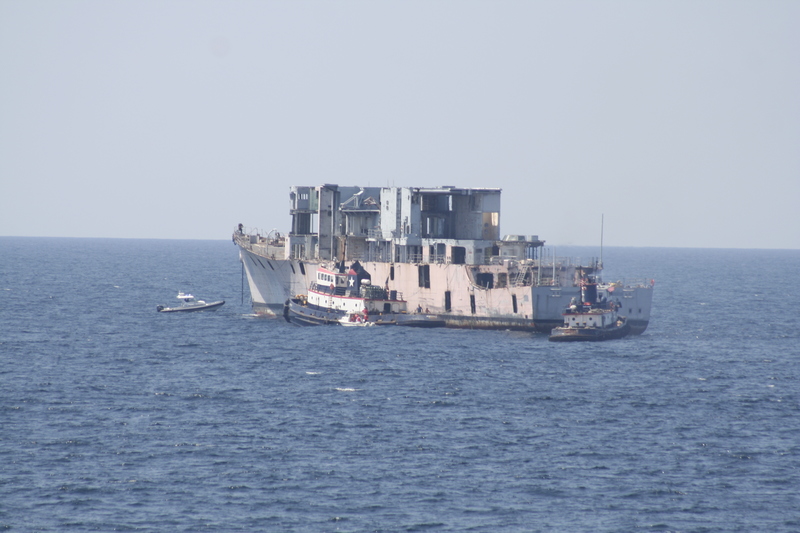The USS Radford is currently lying on the ocean floor. It went down at approximately 4 p.m., Wednesday after months of preparation at the Philadelphia Naval Shipyard.
She sunk rather quickly after lingering on the surface for what seemed like a very long time. We arrived on site at noon and everyone lined the rails of the ferry boat Delaware expecting the ship to sink at any minute. It didn’t. We waited and it kept floating. It wasn’t too long before most of the folks on board wandered away and found other things to do.
Finally, around 3:30, she began to list a bit to port and then the bow started to go down.
There were plenty of holes cut in the side of the ship and once the water level reached them she was gone.
The position of the ship is in 125 to 130 feet of water at the Del-Jersey-Land Reef Site. It is 26 miles northwest of Indian River Inlet at approximately 38 31.600/074 30.600. Jeff Tinsman from the Delaware Reef Program expects to dive on the site next week and be able to give us a more precise location.
Fishing report
The croaker bite in Delaware Bay is off the charts. The fish are so thick that Mike Pizzolato and I were able to catch all we wanted in short order at Reef Site 6. The Lewes charter and head boats are fishing Site 8 and recording enormous numbers of fish. On Tuesday one boat came in with 268 croakers. Before you get all upset about who could possibly eat 268 croakers, let me tell you the anglers were Amish men from Pennsylvania and I feel certain none of those fish were wasted.
The flounder bite is holding up well with keepers coming from the bay and ocean reef sites. As always, you must be on top of the structure to find success.
Spot fishing has been good in the Lewes and Rehoboth Canal, the Broadkill River and from the fishing pier at Cape Henlopen. Unlike croaker that will eat just about anything, spot prefer bloodworms or FishBite imitations. They also require a small hook, and a Sabiki rig is not a bad away to rack up a big score of spot.
B Buoy, A Buoy and the Old Grounds hold some keeper flounder and sea bass along with a good supply of ling. Ling taste better than the other two, have no bag or size limit and can fill a cooler while you wait for a keeper sea bass or flounder.
The inshore waters are seeing more dolphin with some reported as close as B Buoy.
Atlantic bonito, Spanish mackerel and bluefish are also available for those who troll spoons, feathers and bucktails along the Buoy Line out past the Lightship.
Offshore fishing is all about the White Marlin Open. At last count, 15 boats out of Indian River Inlet are entered in the contest trying for the $1 million prize. As of Tuesday evening no qualifying white marlin had been weighed.
I will be fishing in the Open on Thursday and hope to have a complete report by next week.
Indian River Inlet has given up a few keeper flounder and rockfish to those willing to work for them. The best of the rockfish action has been after dark on black plugs, bucktails and eels. During the day, live spot are the ticket to keeper flounder and rock.
The back bays hold good numbers of spot, croaker and flounder. The problem is most of them are too small to keep. When conditions are favorable, it is possible to catch some small spot, put them in a live well and transport the bait to the inlet where with a little luck, you can exchange then for rockfish and flounder.
The surf is summertime slow. A few small blues, rock, kings and spot have been caught by those who are actually fishing during the summer. Most people just put a line over to keep within the law, then enjoy the beautiful beach.
As summer winds down and while the croaker fishing is red hot you should get the family out for a fishing trip. Once you get over a school of croaker the kids will keep you so busy you won’t have time to fish, and that is a good thing.
























































